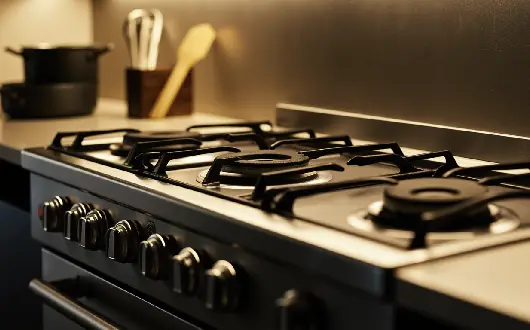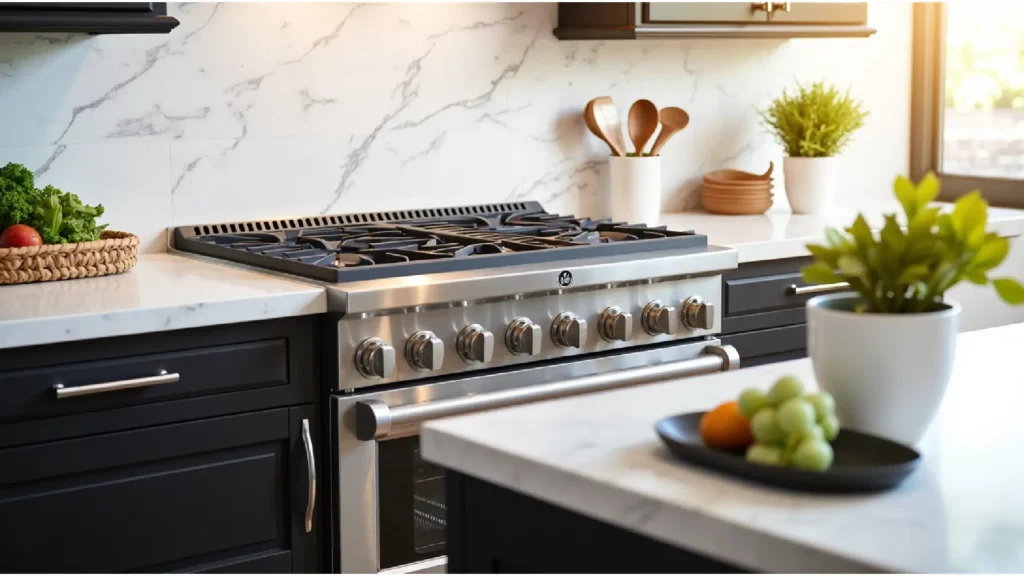
Efficient Cooking with Downdraft 30 Gas Cooktop
So, you’re thinking about upgrading your kitchen, huh? If you’ve been eyeing a Downdraft 30 Gas Cooktop, you’re definitely onto something. These cooktops are not just about cooking; they’re about enhancing your entire kitchen experience.
Imagine whipping up a delicious meal while keeping your kitchen air fresh and clean. Sounds good, right? A downdraft cooktop pulls smoke and odors down through a built-in ventilation system, which is a game-changer for anyone who loves to cook but hates lingering smells.
What’s interesting is that these cooktops come in various styles and designs, making them a stylish addition to any kitchen. Whether you’re a seasoned chef or just someone who enjoys cooking on weekends, a Downdraft 30 Gas Cooktop can elevate your culinary game. Plus, they’re designed to fit seamlessly into your kitchen layout, so you don’t have to sacrifice aesthetics for functionality.
Let’s dive deeper into why this cooktop might just be the perfect fit for you.
Key Takeaways
- A Downdraft 30 Gas Cooktop is a modern and efficient cooking appliance that offers a sleek and space-saving design.
- Using a Downdraft 30 Gas Cooktop provides benefits such as effective ventilation, easy cleanup, and a streamlined cooking experience.
- The features and functions of a Downdraft 30 Gas Cooktop include powerful burners, adjustable fan speeds, and dishwasher-safe filters for convenient maintenance.
- Tips for efficient cooking with a Downdraft 30 Gas Cooktop include using the appropriate cookware, adjusting the fan speed as needed, and keeping the cooktop and filters clean.
- Cleaning and maintenance of a Downdraft 30 Gas Cooktop involve regular wiping down of the surface, cleaning the filters, and inspecting for any signs of wear or damage.
Benefits of Using a Downdraft 30 Gas Cooktop
Effortless Ventilation
One of the most significant advantages of using a Downdraft 30 Gas Cooktop is its ventilation system. We’ve all experienced the lingering smell of fried food that can last for hours. However, with a downdraft system, this issue is eliminated. It efficiently pulls smoke and steam down and out of your kitchen, maintaining fresh and breathable air.
Ideal for Small Spaces
This feature is particularly useful if you live in a smaller space where odors can easily become trapped. The downdraft system ensures that your kitchen remains odor-free, making it an ideal solution for those with limited space.
Instant Temperature Control
Gas cooktops offer another significant benefit: quick heating and instant temperature control. Unlike electric stoves, which can take time to heat up or cool down, gas cooktops provide immediate results. You can adjust the flame to achieve the perfect simmer or boil in no time, giving you more control over your cooking process and leading to better results in the kitchen.
Features and Functions of a Downdraft 30 Gas Cooktop
Now let’s talk about some of the cool features you’ll find in a Downdraft 30 Gas Cooktop. First off, the downdraft ventilation itself is pretty impressive. It usually comes with multiple fan speeds, so you can adjust it based on what you’re cooking.
If you’re just simmering some sauce, you might not need it on high, but if you’re searing meat, cranking it up will help keep your kitchen smoke-free. Another feature worth mentioning is the design of the burners. Many models come with different burner sizes, which is super convenient.
You can use a small burner for delicate tasks like melting chocolate or a larger one for boiling pasta. Some cooktops even have a high-output burner for those times when you need to bring water to a boil in record time. And let’s not forget about the ease of cleaning!
Most models have smooth surfaces that make spills and splatters easier to wipe away.
Tips for Efficient Cooking with a Downdraft 30 Gas Cooktop
| Tip | Description |
|---|---|
| Use proper cookware | Ensure that the cookware is flat and sits properly on the grates to maximize heat transfer. |
| Keep the downdraft vent clear | Regularly clean the vent to maintain efficient ventilation during cooking. |
| Preheat the cooktop | Allow the cooktop to preheat before adding ingredients to ensure even cooking. |
| Adjust flame size | Match the flame size to the size of the cookware to prevent heat loss and improve efficiency. |
| Use the downdraft only when necessary | Turn on the downdraft vent only when cooking generates smoke or strong odors to conserve energy. |
When it comes to cooking efficiently on your Downdraft 30 Gas Cooktop, there are a few tricks that can make a big difference. First off, always use the right-sized pot or pan for the burner you’re using. If you put a small pot on a large burner, you’re wasting energy and time.
Plus, it can lead to uneven cooking, which nobody wants when they’re trying to impress dinner guests. Another tip is to keep your utensils and ingredients within arm’s reach. This might sound simple, but having everything organized can save you precious minutes while cooking.
You don’t want to be running around looking for that spice you just know is hiding somewhere in your pantry! Also, don’t forget to utilize the downdraft ventilation while cooking; turn it on before you start frying or grilling to catch any smoke right away.
Cleaning and Maintenance of a Downdraft 30 Gas Cooktop
Cleaning your Downdraft 30 Gas Cooktop doesn’t have to be a chore if you stay on top of it. After each use, take a moment to wipe down the surface with a damp cloth and some mild detergent. Trust me; it’s way easier to clean up spills right after they happen than waiting until they harden into something unrecognizable!
For deeper cleaning, make sure to check the manufacturer’s instructions regarding the downdraft system itself. Some models have removable filters that need regular cleaning or replacement. Keeping these clean not only helps with ventilation but also ensures that your cooktop runs efficiently.
And let’s be honest—nobody wants to deal with grease buildup!
Safety Considerations when Using a Downdraft 30 Gas Cooktop
Safety should always be top of mind when using any gas appliance, including your Downdraft 30 Gas Cooktop. First things first: make sure your kitchen is well-ventilated when you’re cooking. Even though the downdraft system helps with this, it’s still good practice to open windows or turn on additional fans if you’re cooking something particularly aromatic or smoky.
Also, keep an eye on your pots and pans while they’re on the heat. It’s easy to get distracted by other things happening in the kitchen (or even outside!), but leaving something unattended can lead to accidents. And don’t forget about those knobs!
Make sure they’re turned off completely after use; it’s an easy thing to overlook but super important for safety.
Comparing Downdraft 30 Gas Cooktops to Other Cooking Options
https://www.youtube.com/embed/n80pO0-fLIw
You might be wondering how a Downdraft 30 Gas Cooktop stacks up against other cooking options like electric stoves or induction cooktops. Well, for starters, gas cooktops generally offer better temperature control and quicker heating times compared to electric ones. If you’re someone who loves to experiment with different cooking techniques, gas is often preferred by chefs for its responsiveness.
Induction cooktops are another popular option these days, but they come with their own set of pros and cons. While they heat up quickly and are easy to clean, they require specific types of cookware that are magnetic. So if you’ve got a collection of beautiful pots and pans that aren’t compatible, that could be a dealbreaker.
Plus, some people just love the traditional feel of cooking with gas—it’s hard to replicate that experience with induction.
Conclusion and Final Thoughts on Using a Downdraft 30 Gas Cooktop
In conclusion, if you’re considering adding a Downdraft 30 Gas Cooktop to your kitchen arsenal, I’d say go for it! The benefits—like effective ventilation, quick heating times, and ease of use—make it an excellent choice for both novice cooks and seasoned chefs alike. Plus, the sleek design can really elevate your kitchen’s aesthetic.
Of course, like any appliance, there are things to keep in mind—safety precautions, maintenance needs, and how it compares to other cooking methods are all important factors. But if you’re ready to embrace the world of gas cooking with the added bonus of downdraft ventilation, I think you’ll find it’s worth every penny. Happy cooking!
If you are considering purchasing a downdraft 30 gas cooktop, you may also be interested in reading about the Wolf Gas Cooktop with Downdraft. This article provides a detailed review of the Wolf gas cooktop, highlighting its features and performance. Comparing different options like the Viking 30 inch gas cooktop and the GE gas cooktop can help you make an informed decision when selecting the best downdraft gas cooktop for your kitchen.
FAQs
What is a downdraft 30 gas cooktop?
A downdraft 30 gas cooktop is a type of cooking appliance that combines a gas cooktop with a built-in downdraft ventilation system. This allows for efficient removal of cooking odors, smoke, and grease directly from the cooking surface.
How does a downdraft 30 gas cooktop work?
A downdraft 30 gas cooktop works by drawing cooking fumes and odors downward through a built-in ventilation system, which then expels them outside or filters them through a charcoal filter. This eliminates the need for a separate range hood.
What are the benefits of a downdraft 30 gas cooktop?
Some benefits of a downdraft 30 gas cooktop include space-saving design, efficient ventilation, and a sleek, unobtrusive appearance. It also eliminates the need for a separate range hood, making it a popular choice for kitchens with limited space.
What are the considerations when choosing a downdraft 30 gas cooktop?
When choosing a downdraft 30 gas cooktop, it’s important to consider the ventilation power, size and layout of the cooking surface, and the installation requirements. It’s also important to ensure compatibility with the kitchen’s ventilation system.
Are there any drawbacks to using a downdraft 30 gas cooktop?
Some potential drawbacks of using a downdraft 30 gas cooktop include limited ventilation power compared to traditional range hoods, potential noise from the ventilation system, and the need for regular maintenance of the filters.




